

A superior batch of material presents itself this week, including several classic flying fools, and an array of animation superstars. We’ll also see a Terrytoon, and even a return to the bouncing ball as we sing along with Paramount.
 The Flying Cat (MGM, Tom and Jerry, 1/12/52 – William Hanna/Joseph Barbera) – While no powered flight is involved in this cartoon, Tom manages to construct his own equivalent of “Goofy’s Glider” to go where no cat has gone before – and meet a canary on his own turf. Things haven’t gone well in the early part of the day for the cat, who has his eyes set upon a canary in cage hanging in the window. Good Samaritan Jerry is as usual at the ready to see that his old nemesis doesn’t get any raw breakfast at the expense of others, and effects a rescue of the bird, freeing him from his cage. The bird finds a comfortable alternate abode in a backyard birdhouse, and beckons Jerry up when Tom begins pursuing the mouse for ruining his meal. Tom tries a variety of ways to reach the two upon their high pole, including a ladder (which the bird sets fire to, toasting Tom to a crisp), flying trapeze (losing his grip on the birdhouse platform when Jerry and the canary stomp on Tom’s hands), and pole vaulting (unsuccessful when a roller skate is rolled under Tom’s pole). Tom crashes through the upper story of the house nearby, and comes out the window on the opposite side, dangling from the contents of a dresser drawer above – which includes a ladies’ corset, the arm straps of which wrap around Tom’s arms. By a little creative retying of the leg straps, Tom converts the flaps of the corset into a neat pair of bat wings. He tries out his invention with a soar around the yard. He glides like a dream, and smiles at the audience, proud of his instinctive skill – until he collides headfirst with a mailbox. Maybe he still has a few bugs to work out.
The Flying Cat (MGM, Tom and Jerry, 1/12/52 – William Hanna/Joseph Barbera) – While no powered flight is involved in this cartoon, Tom manages to construct his own equivalent of “Goofy’s Glider” to go where no cat has gone before – and meet a canary on his own turf. Things haven’t gone well in the early part of the day for the cat, who has his eyes set upon a canary in cage hanging in the window. Good Samaritan Jerry is as usual at the ready to see that his old nemesis doesn’t get any raw breakfast at the expense of others, and effects a rescue of the bird, freeing him from his cage. The bird finds a comfortable alternate abode in a backyard birdhouse, and beckons Jerry up when Tom begins pursuing the mouse for ruining his meal. Tom tries a variety of ways to reach the two upon their high pole, including a ladder (which the bird sets fire to, toasting Tom to a crisp), flying trapeze (losing his grip on the birdhouse platform when Jerry and the canary stomp on Tom’s hands), and pole vaulting (unsuccessful when a roller skate is rolled under Tom’s pole). Tom crashes through the upper story of the house nearby, and comes out the window on the opposite side, dangling from the contents of a dresser drawer above – which includes a ladies’ corset, the arm straps of which wrap around Tom’s arms. By a little creative retying of the leg straps, Tom converts the flaps of the corset into a neat pair of bat wings. He tries out his invention with a soar around the yard. He glides like a dream, and smiles at the audience, proud of his instinctive skill – until he collides headfirst with a mailbox. Maybe he still has a few bugs to work out.
 Well, no time like the present for more flight training. Tom climbs to the roof and launches himself, performing a series of graceful circles around the birdhouse pole. Inside, Jerry notes a shadow passing by the light of the circular doorway, and peers outside. The sight of a cat gliding past him causes Jerry to rub his eyes in disbelief, but Tom is still there for a second pass. Jerry runs to alert the canary, reenacting like a mime the sight he has just seen. All the bird can do is break up laughing at such a preposterous story. But Jerry insistently points for the bird to look outside. With disbelieving skepticism, the canary humors Jerry for a look-see. His feathers fly off in shock as Tom makes a close pass. Tom zooms after the bird, right on his tail, until the two collide with the bell of a church steeple tower, reverberating from its metallic clang. The bird returns to Jerry at the birdhouse, and the two take defensive measures, by prying off the wooden roof panels of the birdhouse, then inverting them, leaving a bed of exposed nails protruding skyward. Tom is unable to stop his dive, and lands with his rear end spread squarely over the nails. He leaps off in pain, then falls into a backyard fish pond. Seated in the water, he hears the sound of fluid entering a vessel, then stands up. Holes in his rear end transform him into a living watering can, as sprays of water irrigate a nearby flower bed. Jerry meanwhile attempts to make a break for home, sliding down the birdhouse pole to the ground. No sooner does he touch terra firma, than the growing shadow of the winged Tom looms over him from above. Tom snatches Jerry up in one paw, and keeps on soaring ahead with his catch. Above, the bird watches horrified, then realizes it is his turn to effect a rescue. Flying over Tom’s back, he unties the knots of the straps holding the two panels of material of Tom’s corset together. Tom’s wings split in two, and Tom, losing his grip on Jerry, plummets toward the ground. His legs hit the crotch of the topmost branches of a tall tree, and his momentum slices the tree in two between his legs, leaving him sore and entirely misshapen by the time he reaches the ground. But the resilient cat gets his lacing straight, and is quickly back in the chase again, pursuing the canary carrying Jerry into a railway tunnel. While the mouse and bird are small enough to fit over the top of an oncoming train, Tom is not, and gets hit head-on by the locomotive. Tom lodges in a railway overpass, suspended by his tail and swinging back and forth in compressed form, assuming the role of a railroad crossing signal. Jerry and the canary appear on the caboose of the train, and shake hands at their victory, for the iris out.
Well, no time like the present for more flight training. Tom climbs to the roof and launches himself, performing a series of graceful circles around the birdhouse pole. Inside, Jerry notes a shadow passing by the light of the circular doorway, and peers outside. The sight of a cat gliding past him causes Jerry to rub his eyes in disbelief, but Tom is still there for a second pass. Jerry runs to alert the canary, reenacting like a mime the sight he has just seen. All the bird can do is break up laughing at such a preposterous story. But Jerry insistently points for the bird to look outside. With disbelieving skepticism, the canary humors Jerry for a look-see. His feathers fly off in shock as Tom makes a close pass. Tom zooms after the bird, right on his tail, until the two collide with the bell of a church steeple tower, reverberating from its metallic clang. The bird returns to Jerry at the birdhouse, and the two take defensive measures, by prying off the wooden roof panels of the birdhouse, then inverting them, leaving a bed of exposed nails protruding skyward. Tom is unable to stop his dive, and lands with his rear end spread squarely over the nails. He leaps off in pain, then falls into a backyard fish pond. Seated in the water, he hears the sound of fluid entering a vessel, then stands up. Holes in his rear end transform him into a living watering can, as sprays of water irrigate a nearby flower bed. Jerry meanwhile attempts to make a break for home, sliding down the birdhouse pole to the ground. No sooner does he touch terra firma, than the growing shadow of the winged Tom looms over him from above. Tom snatches Jerry up in one paw, and keeps on soaring ahead with his catch. Above, the bird watches horrified, then realizes it is his turn to effect a rescue. Flying over Tom’s back, he unties the knots of the straps holding the two panels of material of Tom’s corset together. Tom’s wings split in two, and Tom, losing his grip on Jerry, plummets toward the ground. His legs hit the crotch of the topmost branches of a tall tree, and his momentum slices the tree in two between his legs, leaving him sore and entirely misshapen by the time he reaches the ground. But the resilient cat gets his lacing straight, and is quickly back in the chase again, pursuing the canary carrying Jerry into a railway tunnel. While the mouse and bird are small enough to fit over the top of an oncoming train, Tom is not, and gets hit head-on by the locomotive. Tom lodges in a railway overpass, suspended by his tail and swinging back and forth in compressed form, assuming the role of a railroad crossing signal. Jerry and the canary appear on the caboose of the train, and shake hands at their victory, for the iris out.
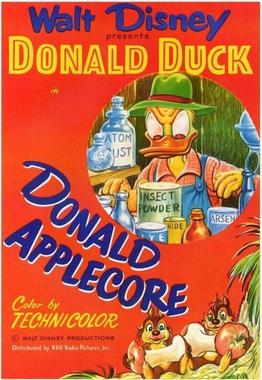 Donald Applecore (Disney/RKO, Donald Duck, 1/18/52 – Jack Hannah, dir.) – Chip ‘n’ Dale are up to their usual, taking residence in Donald’s apple orchards, and leaving a trail of nibbled applecores behind. (Strange, I thought they usually prefer nuts.) When Donald catches one of them in the act, the fast-talking chipmunk whispers conspiratorially into Donald’s ear, detailing their racket, and asks Donald if he wants in. The gullible duck, oblivious to the fact he is stealing from himself, joins in the plot as accessory, carrying a large basket to transport the stolen goods. Instead, the chipmunks use him for a rubbish bin, and dump upon him a load of their trash applecores. Donald is a truly modern farmer, and keeps within his barn a bright red helicopter, unusually controlled by means of a tiller forward of the prop, and equipped with a special reservoir and exhaust system fashioned for crop dusting. Deciding to rid himself of the furry pests in his orchard, Donald loads up the helicopter’s tank with various varieties of insect poison, and lays down a thick smoke screen around the trees where the chipmunks are concealed. After a few moments, Donald is satisfied the chemicals must have done their job, and re-enters the orchard as the smoke clears. But Donald is displeased once he can see past the dissipating fumes – as the chipmunks are alive and well, having donned gas masks during the attack. (I hope the writers properly calculated the potency of the D.D.T. prevalent in those days.) Unable to make the chipmunks leave, Donald at least sets himself to recover his stolen stock. He taps at the trunk of the tree housing the chipmunks, until he hears a deadened thump that does not sound wooden. Using the tail rotor of his helicopter like a buzzsaw, Donald cuts a circular hole in the tree trunk, and the chipmunks’ supply of apples pours out neatly into the cockpit. Donald flies his cargo over to a large storage silo, landing the copter’s forward wheel on a small foot pedal at the base of the silo. The roof of the silo opens at a 45 degree angle, just as if the structure were a giant kitchen trash can. Using the copter’s custom exhaust, Donald shoots his cargo of apples one by one out the exhaust pipe into the silo. The chipmunks discover the loss of their storage, and follow Donald to the silo. Being on the ground instead of the roof, they look for another way inside, and find a curved hatch door in the silo’s side. The apples are well packed, and opening the door at first accomplishes nothing, as the apples just sit there without being disturbed. Dale, however, just can’t resist pulling one apple out from the bottom – and the whole silo empties as if watching an apple stampede.
Donald Applecore (Disney/RKO, Donald Duck, 1/18/52 – Jack Hannah, dir.) – Chip ‘n’ Dale are up to their usual, taking residence in Donald’s apple orchards, and leaving a trail of nibbled applecores behind. (Strange, I thought they usually prefer nuts.) When Donald catches one of them in the act, the fast-talking chipmunk whispers conspiratorially into Donald’s ear, detailing their racket, and asks Donald if he wants in. The gullible duck, oblivious to the fact he is stealing from himself, joins in the plot as accessory, carrying a large basket to transport the stolen goods. Instead, the chipmunks use him for a rubbish bin, and dump upon him a load of their trash applecores. Donald is a truly modern farmer, and keeps within his barn a bright red helicopter, unusually controlled by means of a tiller forward of the prop, and equipped with a special reservoir and exhaust system fashioned for crop dusting. Deciding to rid himself of the furry pests in his orchard, Donald loads up the helicopter’s tank with various varieties of insect poison, and lays down a thick smoke screen around the trees where the chipmunks are concealed. After a few moments, Donald is satisfied the chemicals must have done their job, and re-enters the orchard as the smoke clears. But Donald is displeased once he can see past the dissipating fumes – as the chipmunks are alive and well, having donned gas masks during the attack. (I hope the writers properly calculated the potency of the D.D.T. prevalent in those days.) Unable to make the chipmunks leave, Donald at least sets himself to recover his stolen stock. He taps at the trunk of the tree housing the chipmunks, until he hears a deadened thump that does not sound wooden. Using the tail rotor of his helicopter like a buzzsaw, Donald cuts a circular hole in the tree trunk, and the chipmunks’ supply of apples pours out neatly into the cockpit. Donald flies his cargo over to a large storage silo, landing the copter’s forward wheel on a small foot pedal at the base of the silo. The roof of the silo opens at a 45 degree angle, just as if the structure were a giant kitchen trash can. Using the copter’s custom exhaust, Donald shoots his cargo of apples one by one out the exhaust pipe into the silo. The chipmunks discover the loss of their storage, and follow Donald to the silo. Being on the ground instead of the roof, they look for another way inside, and find a curved hatch door in the silo’s side. The apples are well packed, and opening the door at first accomplishes nothing, as the apples just sit there without being disturbed. Dale, however, just can’t resist pulling one apple out from the bottom – and the whole silo empties as if watching an apple stampede.
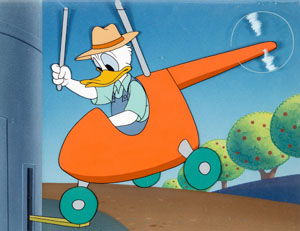 Upon the loss of his apples again, Donald gets tough. He loads into the crop-dusting reservoir cartoon science’s latest innovation in pest eradication – Atomic Pills, which, when stirred with other contents of the reservoir, emit a compact version of a mushroom cloud. Closing the compartment lid, Donald sets off in a chase after the chipmunks, taking pot shots from his exhaust with the pills. One errant shot blasts his silo down to roof and conecting rings. Another shot disintegrates a haystack the chipmunks are hiding in. As the smoke clears, Dale displays that he has found the proverbial needle hidden in the hay. Finally a shot of a pill takes a bad bounce, and hops up the steps of and into Donald’s chicken house. Before Donald can land to get inside, a nesting hen discovers and swallows the pill. Donald enters in search for it, finding nothing, but is just in time to witness the hen laying an egg, which rolls down a short chute from her nest. Donald picks up the egg proudly for inspection, then notices that it is ticking like a time bomb. “A ticking egg?”, he questions. Suddenly, an alarm bell sounds from inside the egg, and a moment later, all that is left is a large crater where Donald had stood, and the hen nearby, denuded of feathers from the blast. Chip and Dale listen at the edge of the crater, as Donald below converses on the other side of the planet with someone bantering away in Chinese. Dale tosses into the hole an applecore, supplying ammunition to the Chinaman to throw at Donald, leaving the chips laughing for the iris out.
Upon the loss of his apples again, Donald gets tough. He loads into the crop-dusting reservoir cartoon science’s latest innovation in pest eradication – Atomic Pills, which, when stirred with other contents of the reservoir, emit a compact version of a mushroom cloud. Closing the compartment lid, Donald sets off in a chase after the chipmunks, taking pot shots from his exhaust with the pills. One errant shot blasts his silo down to roof and conecting rings. Another shot disintegrates a haystack the chipmunks are hiding in. As the smoke clears, Dale displays that he has found the proverbial needle hidden in the hay. Finally a shot of a pill takes a bad bounce, and hops up the steps of and into Donald’s chicken house. Before Donald can land to get inside, a nesting hen discovers and swallows the pill. Donald enters in search for it, finding nothing, but is just in time to witness the hen laying an egg, which rolls down a short chute from her nest. Donald picks up the egg proudly for inspection, then notices that it is ticking like a time bomb. “A ticking egg?”, he questions. Suddenly, an alarm bell sounds from inside the egg, and a moment later, all that is left is a large crater where Donald had stood, and the hen nearby, denuded of feathers from the blast. Chip and Dale listen at the edge of the crater, as Donald below converses on the other side of the planet with someone bantering away in Chinese. Dale tosses into the hole an applecore, supplying ammunition to the Chinaman to throw at Donald, leaving the chips laughing for the iris out.
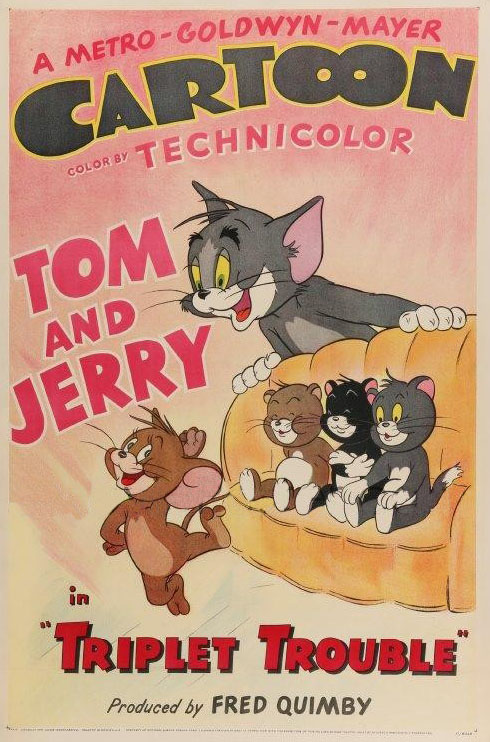 Triplet Trouble (MGM, Tom and Jerry, 4/19/52 – William Hanna/Joseph Barbera, dir.) One of those periodic instances when the cat and mouse are forced to team up to outwit a set of common adversaries. A neighbor leaves three adorable kittens with Mammy Two Shoes to keep an eye on for the afternoon. While the three act like angels in front of the humans, their true devilish side reveals itself when human eyes are not upon them, and they assume the role of little tough guys determined to take over the household and make life generally miserable for anyone who crosses their path. Poor Tom is the first to receive their treatment, the kittens faking him out with overtures of friendship, then letting him have it when he least expects it. Jerry’s laughing up a storm on the sidelines, but when the kittens catch sight of him, they don’t care if he’s a rooting section for them or not. To them, he’s just a mouse – and another easy target. Jerry soon finds himself getting knocked around as badly as Tom from the three living whirlwinds, and both Tom and Jerry wind up on the outside of the house looking in, as the kittens take over chair, bowl, and living room, giving themselves the run of the place. Tom and Jerry exchange looks, and Jerry gives Tom a wave to follow him to the rear entrance to the kitchen. A truce has been silently formed.
Triplet Trouble (MGM, Tom and Jerry, 4/19/52 – William Hanna/Joseph Barbera, dir.) One of those periodic instances when the cat and mouse are forced to team up to outwit a set of common adversaries. A neighbor leaves three adorable kittens with Mammy Two Shoes to keep an eye on for the afternoon. While the three act like angels in front of the humans, their true devilish side reveals itself when human eyes are not upon them, and they assume the role of little tough guys determined to take over the household and make life generally miserable for anyone who crosses their path. Poor Tom is the first to receive their treatment, the kittens faking him out with overtures of friendship, then letting him have it when he least expects it. Jerry’s laughing up a storm on the sidelines, but when the kittens catch sight of him, they don’t care if he’s a rooting section for them or not. To them, he’s just a mouse – and another easy target. Jerry soon finds himself getting knocked around as badly as Tom from the three living whirlwinds, and both Tom and Jerry wind up on the outside of the house looking in, as the kittens take over chair, bowl, and living room, giving themselves the run of the place. Tom and Jerry exchange looks, and Jerry gives Tom a wave to follow him to the rear entrance to the kitchen. A truce has been silently formed.
A short time later, Tom is seen inside the kitchen, with an innertube nailed across the room’s interior doorway, which he stretches to wrap around a wheeled wooden folding table, upon which is loaded a cargo of three custard pies and one watermelon. Tom struggles to stretch the innertube to maximum extension, while Jerry waits on the kitchen windowsill with a rope and hook, tied off outside. Jerry fastens the hook onto the rear of the folding table, maintaining the table’s position at maximum rubber-band extension, while Tom dons a pair of aviator’s goggles and hops onto the table. Receiving a high sign from Tom that he’s ready, Jerry bravely enters the living room, where the kittens are helping themselves to Tom’s bowl of milk, through three straws. Jerry walks up to the bowl, and slurps up the remainder of its contents into his own cheeks, as the puzzled kittens look upon him sternly at this act of gall.
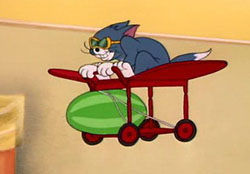 Jerry returns the milk to them – by spitting a stream of it into each of their faces. Jerry runs toward the kitchen, with the three drenched kits in pursuit. However, they stop cold at the kitchen doorway, finding themselves staring down the flight path of Tom and the innertube. Tom cuts the rope holding back the table, and the wheeled apparatus zooms forward. Tom extends the “wings” of the table, and it is suddenly airborne, soaring around the living room. The kittens try to take refuge behind a sofa, while Tom readies the custard pies. Jerry gives a loud whistle to arouse the kittens and make them look. As each pops his head above the soda cushions, Tom, with precision, launches his pies, so that their faces collide with their own respective pie on cue. However, Tom has a bit too much momentum, and as the kittens duck again, Tom soars right over their heads, crashing through the living room window. Jerry is taken aback by this unexpected turn of events, and finds himself on the run again as the three cats give chase, more determined than ever to have their vengeance. But Tom is a skilled navigator, and negotiates a circular path outside, to re-enter the house through an upper story window. Soaring down the staircase, he launches the watermelon. The first two kittens duck again, but the third takes the shot right down his throat, transforming into the dimensions of what he has just swallowed. Tom continues his descent, and scoops up the three cats on the lower platform between the table’s legs, again soaring out the window. When he is above the back yard, he somehow opens the lower platform of the table like a bomb bay door, dumping the kittens out onto the arms of a rotating backyard clothes-pole. Jerry stands on a nearby fence post, armed with a large paddle, while Tom lands and produces paper and scissors, beginning to cut out patterns. As Mammy Two Shoes returns home, she finds her three “little angels” dressed the part – in paper wings fashioned by Tom, flying around the clothes pole while getting paddy-whacked by Jerry, their rears aglow with circular imprints resembling a halo from the paddling, for the iris out.
Jerry returns the milk to them – by spitting a stream of it into each of their faces. Jerry runs toward the kitchen, with the three drenched kits in pursuit. However, they stop cold at the kitchen doorway, finding themselves staring down the flight path of Tom and the innertube. Tom cuts the rope holding back the table, and the wheeled apparatus zooms forward. Tom extends the “wings” of the table, and it is suddenly airborne, soaring around the living room. The kittens try to take refuge behind a sofa, while Tom readies the custard pies. Jerry gives a loud whistle to arouse the kittens and make them look. As each pops his head above the soda cushions, Tom, with precision, launches his pies, so that their faces collide with their own respective pie on cue. However, Tom has a bit too much momentum, and as the kittens duck again, Tom soars right over their heads, crashing through the living room window. Jerry is taken aback by this unexpected turn of events, and finds himself on the run again as the three cats give chase, more determined than ever to have their vengeance. But Tom is a skilled navigator, and negotiates a circular path outside, to re-enter the house through an upper story window. Soaring down the staircase, he launches the watermelon. The first two kittens duck again, but the third takes the shot right down his throat, transforming into the dimensions of what he has just swallowed. Tom continues his descent, and scoops up the three cats on the lower platform between the table’s legs, again soaring out the window. When he is above the back yard, he somehow opens the lower platform of the table like a bomb bay door, dumping the kittens out onto the arms of a rotating backyard clothes-pole. Jerry stands on a nearby fence post, armed with a large paddle, while Tom lands and produces paper and scissors, beginning to cut out patterns. As Mammy Two Shoes returns home, she finds her three “little angels” dressed the part – in paper wings fashioned by Tom, flying around the clothes pole while getting paddy-whacked by Jerry, their rears aglow with circular imprints resembling a halo from the paddling, for the iris out.
 The Foolish Duckling (Terrytoons/Fox, Dinky Duck, 5/16/52 – Mannie Davis, dir.) – One of a number of episodes of the series from the 1950’s. frameworked in the form of a mini-morality play, with narration provided in musical Grecian-chorus style by The Satisfiers. While the other ducklings study hard to train for flying, in preparation for the long journey South they will face in winter, Dinky fritters away his time composing poetry. He lounges on an inflated innertube in the pond, snoozes under a tree, and intermittently thinks up rudimentary rhymes. The other ducks learn mass takeoffs and flying in formation, and eventually solo performing graceful loops and banks to earn their diplomas. “It doesn’t mean a thing to me. I much prefer my poetry”, responds Dinky. The chill of winter arrives, and the entire community takes off in a V formation – leaving the flightless Dinky stranded behind. Snow covers the ground, and Dinky is whipped around by spiraling winter winds, finally taking refuge in the trunk of a hollow tree, shivering with cold, and vowing that if he ever gets out of this, he’ll never ignore his lessons again. No sooner does he make this promise, than the clouds thin and dissipate, a ray of sunlight breaking through, in which travels a pelican mailman, delivering an air mail special delivery letter to Dinky Duck. The letter is from the Ducky-Wucky Cereal Company, announcing that the poem that he submitted to a contest has been awarded first prize – an all-expenses-paid airline trip to Florida. The next day, the migrating duck flock are passed in the sky by a DC-3 passenger plane, in which Dinky sits in a first-class seat, being fed sandwiches by a pretty stewardess, and waving out te window to his surprised friends and neighbors. However, the narrating singers indicate that Dinky has learned his lesson, and intends to make good on his promise for next season by learning to fly.
The Foolish Duckling (Terrytoons/Fox, Dinky Duck, 5/16/52 – Mannie Davis, dir.) – One of a number of episodes of the series from the 1950’s. frameworked in the form of a mini-morality play, with narration provided in musical Grecian-chorus style by The Satisfiers. While the other ducklings study hard to train for flying, in preparation for the long journey South they will face in winter, Dinky fritters away his time composing poetry. He lounges on an inflated innertube in the pond, snoozes under a tree, and intermittently thinks up rudimentary rhymes. The other ducks learn mass takeoffs and flying in formation, and eventually solo performing graceful loops and banks to earn their diplomas. “It doesn’t mean a thing to me. I much prefer my poetry”, responds Dinky. The chill of winter arrives, and the entire community takes off in a V formation – leaving the flightless Dinky stranded behind. Snow covers the ground, and Dinky is whipped around by spiraling winter winds, finally taking refuge in the trunk of a hollow tree, shivering with cold, and vowing that if he ever gets out of this, he’ll never ignore his lessons again. No sooner does he make this promise, than the clouds thin and dissipate, a ray of sunlight breaking through, in which travels a pelican mailman, delivering an air mail special delivery letter to Dinky Duck. The letter is from the Ducky-Wucky Cereal Company, announcing that the poem that he submitted to a contest has been awarded first prize – an all-expenses-paid airline trip to Florida. The next day, the migrating duck flock are passed in the sky by a DC-3 passenger plane, in which Dinky sits in a first-class seat, being fed sandwiches by a pretty stewardess, and waving out te window to his surprised friends and neighbors. However, the narrating singers indicate that Dinky has learned his lesson, and intends to make good on his promise for next season by learning to fly.
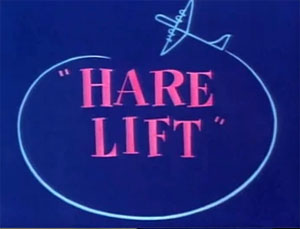 Hare Lift (Warner, Bugs Bunny, 12/20/52 – I. (Friz) Freleng, dir.) – Bugs seems to have moved back to his old residence on the military air base from Falling Hare, with a rabbit hole right in the middle of the field. A newspaper article announces the testing of the world’s largest plane (not quite as big as Superman’s model in Japoteurs, but close). It taxis in and parks with one tire directly over Bugs’ hole. Likely suspecting a return to WWII blackouts, Bugs pops his head out from under the humongous hunk of rubber, and struggles his way out, complaining about whoever parked this “donut” over his home. Once outside, however, Bugs is impressed with “some hunk of aircraft”, and, finding an operating escalator to the entrance door, decides to take “the 50¢ tour.” He finds the plane totally deserted, but continues his tour without a guide, referring to the cavernous insides as “the Grand Central Station with wings.”
Hare Lift (Warner, Bugs Bunny, 12/20/52 – I. (Friz) Freleng, dir.) – Bugs seems to have moved back to his old residence on the military air base from Falling Hare, with a rabbit hole right in the middle of the field. A newspaper article announces the testing of the world’s largest plane (not quite as big as Superman’s model in Japoteurs, but close). It taxis in and parks with one tire directly over Bugs’ hole. Likely suspecting a return to WWII blackouts, Bugs pops his head out from under the humongous hunk of rubber, and struggles his way out, complaining about whoever parked this “donut” over his home. Once outside, however, Bugs is impressed with “some hunk of aircraft”, and, finding an operating escalator to the entrance door, decides to take “the 50¢ tour.” He finds the plane totally deserted, but continues his tour without a guide, referring to the cavernous insides as “the Grand Central Station with wings.”
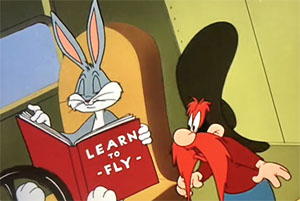 Meanwhile, at a nearby bank, hold-up man Yosemite Sam is telling the tellers to “Keep reachin’ for the ceiling, until ya reach it.” He exits with a sack of stolen loot, and wipes away the figures of the bank’s stated assets on the window ahead of the decimal point, reducing the figure to eight cents. In a jalopy getaway car, he proceeds at the vehicle’s top speed to the air field. (One would think he’d have chosen a civilian field, rather than risk security at a military installation. But I guess it must be visitor’s day.) He boards the giant plane, to find Bugs sitting in the pilot’s seat, trying on the Captain’s hat for size, and playing that he is shooting the plane’s machine guns. Guns become more of a reality, as one of Yosemite’s revolvers is aimed at his head. Without allowing Bugs to explain, Yosemite orders the rabbit to take off. Bugs stares at a control panel containing about two-thirds the dials and buttons of Tex Avery’s, and makes a random selection of a button to push. Beginner’s dumb luck – he finds the starter. The plane begins to move – in the wrong direction, taxiing down the street of a crowded city. Bugs soon finds himself approaching a tall skyscraper head on. Taking another wild guess, Bugs pulls back on the control stick, and the plane tilts 90 degrees, and roars into the sky straight up, directly parallel with the walls of the building. While Bugs is in a comfortable seat, Yosemite is not buckled in, and the sudden shift of direction sends him falling helplessly through the ship’s cabin, landing with a thud inside the glass of the rear gunner’s turret. He stares downward through the glass at the planet Earth far below him, growing smaller and smaller in view. Meanwhile, Bugs is seeing the opposite viewpoint – an imminent head-on collision with the craters of the moon. Bugs pushes the stick forward, performing a quick reversal of direction. Once again, the untethered Yosemite falls through the cabin, now crashing into the metal door behind the pilot’s cockpit.
Meanwhile, at a nearby bank, hold-up man Yosemite Sam is telling the tellers to “Keep reachin’ for the ceiling, until ya reach it.” He exits with a sack of stolen loot, and wipes away the figures of the bank’s stated assets on the window ahead of the decimal point, reducing the figure to eight cents. In a jalopy getaway car, he proceeds at the vehicle’s top speed to the air field. (One would think he’d have chosen a civilian field, rather than risk security at a military installation. But I guess it must be visitor’s day.) He boards the giant plane, to find Bugs sitting in the pilot’s seat, trying on the Captain’s hat for size, and playing that he is shooting the plane’s machine guns. Guns become more of a reality, as one of Yosemite’s revolvers is aimed at his head. Without allowing Bugs to explain, Yosemite orders the rabbit to take off. Bugs stares at a control panel containing about two-thirds the dials and buttons of Tex Avery’s, and makes a random selection of a button to push. Beginner’s dumb luck – he finds the starter. The plane begins to move – in the wrong direction, taxiing down the street of a crowded city. Bugs soon finds himself approaching a tall skyscraper head on. Taking another wild guess, Bugs pulls back on the control stick, and the plane tilts 90 degrees, and roars into the sky straight up, directly parallel with the walls of the building. While Bugs is in a comfortable seat, Yosemite is not buckled in, and the sudden shift of direction sends him falling helplessly through the ship’s cabin, landing with a thud inside the glass of the rear gunner’s turret. He stares downward through the glass at the planet Earth far below him, growing smaller and smaller in view. Meanwhile, Bugs is seeing the opposite viewpoint – an imminent head-on collision with the craters of the moon. Bugs pushes the stick forward, performing a quick reversal of direction. Once again, the untethered Yosemite falls through the cabin, now crashing into the metal door behind the pilot’s cockpit.
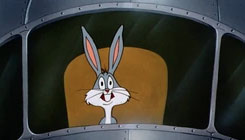 Yosemite storms into the cockpit, ready to give the pilot a pirce of his mind, and a possible few pieces of lead. He nearly goes into shock, at finding Bugs calmly thumbing through a large volume titled “Learn to Fly.” “Great Horny Toads!” he exclaims. Sam races forward to look out the cockpit window, and sees the Earth approaching. Pulling out his revolver, Sam orders Bugs to read faster. No one bosses Bugs around, and the rabbit shuts the book, and in a voice unphased by emotion, announces, “I refuse to look up any more reference because you talk mean to me. Say you’re sorry.” This goes against the grain of all that Sam stands for, and he slaps himself on the forehead and mutters “Oh, no”. He tries to hold out, and delays to take another look out the window. The outline of the USA now fills his viewpoint. “Okay, ya crazy galoot – – I’m sorry”, utters Sam, swallowing his pride. “Say you’re sorry with sugar on it”, responds Bugs, determined to push Sam’s buttons. “No. No! NEVER!”, states the stubborn Sam. In a classic standoff, Bugs relaxes and refuses to do anything, while Sam pretends to bide his time as if there is nothing to worry about, nervously humming to himself while playing with a yo-yo, and breaking out a ball and a set of jacks to bounce on the floor, hoping the determination of the rabbit will break. But Bugs’ will remains one of iron, and the perspiring Sam dashes to look out the window again, now seeing fields and farmhouses only a few thousand feet away. “I’m sorry with sugar on it”, he emotionally pleads. “That’s better. I’ll see what I can do”, says Bugs, without any intonation spelling commitment. “YAAAAH!” screams Yosemite, huddling in terror behind the pilot’s seat at the sound of Bugs’ empty promise. But Bugs either knows more than he is letting on, or relies again upon his sheer dumb luck, and pushes another button, bringing the plane out of its dive with so little margin for error, the plane’s wake pulls upon and stretches trees and buildings below. “I guess that was it”, Bugs comments in matter-of-factly tone.
Yosemite storms into the cockpit, ready to give the pilot a pirce of his mind, and a possible few pieces of lead. He nearly goes into shock, at finding Bugs calmly thumbing through a large volume titled “Learn to Fly.” “Great Horny Toads!” he exclaims. Sam races forward to look out the cockpit window, and sees the Earth approaching. Pulling out his revolver, Sam orders Bugs to read faster. No one bosses Bugs around, and the rabbit shuts the book, and in a voice unphased by emotion, announces, “I refuse to look up any more reference because you talk mean to me. Say you’re sorry.” This goes against the grain of all that Sam stands for, and he slaps himself on the forehead and mutters “Oh, no”. He tries to hold out, and delays to take another look out the window. The outline of the USA now fills his viewpoint. “Okay, ya crazy galoot – – I’m sorry”, utters Sam, swallowing his pride. “Say you’re sorry with sugar on it”, responds Bugs, determined to push Sam’s buttons. “No. No! NEVER!”, states the stubborn Sam. In a classic standoff, Bugs relaxes and refuses to do anything, while Sam pretends to bide his time as if there is nothing to worry about, nervously humming to himself while playing with a yo-yo, and breaking out a ball and a set of jacks to bounce on the floor, hoping the determination of the rabbit will break. But Bugs’ will remains one of iron, and the perspiring Sam dashes to look out the window again, now seeing fields and farmhouses only a few thousand feet away. “I’m sorry with sugar on it”, he emotionally pleads. “That’s better. I’ll see what I can do”, says Bugs, without any intonation spelling commitment. “YAAAAH!” screams Yosemite, huddling in terror behind the pilot’s seat at the sound of Bugs’ empty promise. But Bugs either knows more than he is letting on, or relies again upon his sheer dumb luck, and pushes another button, bringing the plane out of its dive with so little margin for error, the plane’s wake pulls upon and stretches trees and buildings below. “I guess that was it”, Bugs comments in matter-of-factly tone.
 Bugs decides he’d better radio the authorities to bring back the ship. Sam will have none of this, and orders Bugs to hand over the flight instruction book. Bugs holds the book out before him as if ready to hand it to Sam – then lets it fall to the floor, followed by giving the volume a solid kick toward the open entrance door on the plane. Yosemite runs headlong after the book, following it into open air as it sails out of the plane. Although he gets his hands on it, his panic at finding himself standing on nothing causes him to drop the book, and in a standard classic mad scramble he claws his way through the ether back into the plane. A gag is repeated from “Falling Hare”, as Bugs drops a banana peel into Sam’s path, sliding him out the door on the opposite side. As in the earlier cartoon, Sam saves himself by clinging to the ourside of the door, looking like he is about to suffer the same near heart-attack as Bugs did at the hands of the Gremlin. Also following the lead of Falling Hare, Bugs, while cornered with his hands up, releases the handle for a bomb bay door, almost succeeding in dropping Sam out of the picture. Bugs returns to the cockpit and sings a few bars of “Captains of the Clouds” from the feature of the same name. Sam reappears, insisting he’s taking control of the flight, and orders Bugs to give him the wheel. Bugs responds by ripping out the whole wheel and control stick, tossing it over Sam’s head out the cockpit window. As the plane sets itself into a dive, desperate Sam starts pushing buttons on the control panel, one of them marked “Robot Pilot”. From a cabinet in the rear of the plane emerges a genuine metal robot, who knows better than to get mixed up in these things. He grabs one of two parachutes from an emergency compartment, and hits the silk in a jump out the cabin door. Both Bugs and Sam stare confused from the doorway. “That leaves only one parachute”, notes Bugs. “We’ll have to draw straws to see who gets it.” Sam has his own ideas. “You draw the straws – I’m a-takin’ the parachute!” Fastening on the apparatus, and grabbing his money sack, Sam yells “Geronimo” and waves a taunting goodbye to Bugs. If only he could have planned his trajectory. Instead, Sam drops in upon an open parade limousine, fully occupied by police dignitaries, as the parachute covers all to conceal what will become of Sam. There’s still the matter of the falling plane, and Bugs pulls a revision upon the ending of “Falling Hare”. Instead of running out of gas. Bugs pulls back on a large lever, which stops the plane in its tracks, inches from the ground. Mopping his brow, Bugs addresses the audience: “Lucky this thing had air brakes.”
Bugs decides he’d better radio the authorities to bring back the ship. Sam will have none of this, and orders Bugs to hand over the flight instruction book. Bugs holds the book out before him as if ready to hand it to Sam – then lets it fall to the floor, followed by giving the volume a solid kick toward the open entrance door on the plane. Yosemite runs headlong after the book, following it into open air as it sails out of the plane. Although he gets his hands on it, his panic at finding himself standing on nothing causes him to drop the book, and in a standard classic mad scramble he claws his way through the ether back into the plane. A gag is repeated from “Falling Hare”, as Bugs drops a banana peel into Sam’s path, sliding him out the door on the opposite side. As in the earlier cartoon, Sam saves himself by clinging to the ourside of the door, looking like he is about to suffer the same near heart-attack as Bugs did at the hands of the Gremlin. Also following the lead of Falling Hare, Bugs, while cornered with his hands up, releases the handle for a bomb bay door, almost succeeding in dropping Sam out of the picture. Bugs returns to the cockpit and sings a few bars of “Captains of the Clouds” from the feature of the same name. Sam reappears, insisting he’s taking control of the flight, and orders Bugs to give him the wheel. Bugs responds by ripping out the whole wheel and control stick, tossing it over Sam’s head out the cockpit window. As the plane sets itself into a dive, desperate Sam starts pushing buttons on the control panel, one of them marked “Robot Pilot”. From a cabinet in the rear of the plane emerges a genuine metal robot, who knows better than to get mixed up in these things. He grabs one of two parachutes from an emergency compartment, and hits the silk in a jump out the cabin door. Both Bugs and Sam stare confused from the doorway. “That leaves only one parachute”, notes Bugs. “We’ll have to draw straws to see who gets it.” Sam has his own ideas. “You draw the straws – I’m a-takin’ the parachute!” Fastening on the apparatus, and grabbing his money sack, Sam yells “Geronimo” and waves a taunting goodbye to Bugs. If only he could have planned his trajectory. Instead, Sam drops in upon an open parade limousine, fully occupied by police dignitaries, as the parachute covers all to conceal what will become of Sam. There’s still the matter of the falling plane, and Bugs pulls a revision upon the ending of “Falling Hare”. Instead of running out of gas. Bugs pulls back on a large lever, which stops the plane in its tracks, inches from the ground. Mopping his brow, Bugs addresses the audience: “Lucky this thing had air brakes.”
Substantial footage from this short was reused as an introductory sequence to the 1963 cheater, Devil’s Feud Cake, adding a new shot to have Sam’s parachute fail, winding him up on a one-way ticket to the underworld and a meeting with Satan himself. Later, Friz Freleng would produce a cheater from the cheater, expanding “Devil’s Feud Cake” as formatting animation for the first half of The Looney Looney Looney Bugs Bunny Movie (1983).
 Duck Amuck (Warner, Daffy Duck, 2/28/53 – Charles M. (Chuck) Jones, dir.) – A brilliant satirical behind-the scenes look into the workings of an animation studio, exploring the possibilities for mayhem when a star character is supplied with a mystery substitute animator. Murphy’s law prevails, as anything that can go wrong does. What starts out as a Musketeer picture turns into chaos, when the backgrounds supplied to Daffy don’t match the picture’s setting, changing from farm to igloo to Hawaiian. Daffy tries to keep up with quick costume changes to match the new settings and climates, but finally walks onto paper where no background has been painted at all – and begins to have it out verbally with whoever the shlock artist is who’s in charge of the pen. Camera techniques are handled like never before. As Daffy calls for a close up, the animator instead shrinks the screen to postage stamp size to surround the distant image of the duck – then, when Daffy complains, the camera zooms in so close, the screen is entirely filled by Daffy’s bloodshot eyeballs. Projection of the picture is disrupted so that the line dividing sequential frames moves into the middle of the picture, producing a split screen, where a Daffy in the upper frame bickers with a twin Daffy in the next frame below. The animator refuses to keep the images of Daffy “on model”, and redraws him as a quadruped flower-head monster with a flag flying from his tail with the image of a screw and a ball.
Duck Amuck (Warner, Daffy Duck, 2/28/53 – Charles M. (Chuck) Jones, dir.) – A brilliant satirical behind-the scenes look into the workings of an animation studio, exploring the possibilities for mayhem when a star character is supplied with a mystery substitute animator. Murphy’s law prevails, as anything that can go wrong does. What starts out as a Musketeer picture turns into chaos, when the backgrounds supplied to Daffy don’t match the picture’s setting, changing from farm to igloo to Hawaiian. Daffy tries to keep up with quick costume changes to match the new settings and climates, but finally walks onto paper where no background has been painted at all – and begins to have it out verbally with whoever the shlock artist is who’s in charge of the pen. Camera techniques are handled like never before. As Daffy calls for a close up, the animator instead shrinks the screen to postage stamp size to surround the distant image of the duck – then, when Daffy complains, the camera zooms in so close, the screen is entirely filled by Daffy’s bloodshot eyeballs. Projection of the picture is disrupted so that the line dividing sequential frames moves into the middle of the picture, producing a split screen, where a Daffy in the upper frame bickers with a twin Daffy in the next frame below. The animator refuses to keep the images of Daffy “on model”, and redraws him as a quadruped flower-head monster with a flag flying from his tail with the image of a screw and a ball.
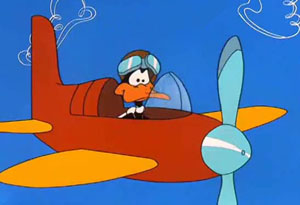 Toward the end of the film, Daffy finally thinks the picture is starting to get somewhere, as the artist draws a pair of aviator’s goggles upon Daffy’s head, and places him in the cockpit of a modern plane for testing. “Oh, brother, I’m a buzz boy”, remarks Daffy, eager to accept his new role. He does not realize that the animator is already booby-trapping his path, drawing a high mountain peak directly in his way. An offscreen crash is heard, then Daffy and the cockpit windows pass in the sky, minus any plane (shades of “Super Rabbit”!) “Time to hit the ol’ silk”, says a dismayed Daffy, and jumps, pulling a ripcord which opens a safety parachute for him to float gently down. Unfortunately, the eraser end of a pencil enters the frame, removing from the drawing the silken parachute, then drawing in an anvil on the other end of the strings to replace it. The anvil follows like the lead weight it is, knocking Daffy out of the sky. On the ground, a dazed Daffy hammers at the anvil, performing a seemingly intoxicated or incoherent rendition of the poem, “The Village Blacksmith” by Longfellow. The animator’s drawing tools enter the frame again, substituting a large aerial bomb shell in place of the anvil, to fall under the blows of Daffy’s hammer. Ker-BOOM! Charred, but still livid, Daffy screams “Who are you?”, and demands that the artist show himself. The paintbrush enters the frame, draws a door in front of the screaming duck, then shuts it in his face, never letting the duck find out who has made him the fall guy. Only the audience is made privy to the secret, as the camera pulls back to reveal Bugs Bunny at an animator’s desk, turning to the audience to declare, “Ain’t I a stinker?”
Toward the end of the film, Daffy finally thinks the picture is starting to get somewhere, as the artist draws a pair of aviator’s goggles upon Daffy’s head, and places him in the cockpit of a modern plane for testing. “Oh, brother, I’m a buzz boy”, remarks Daffy, eager to accept his new role. He does not realize that the animator is already booby-trapping his path, drawing a high mountain peak directly in his way. An offscreen crash is heard, then Daffy and the cockpit windows pass in the sky, minus any plane (shades of “Super Rabbit”!) “Time to hit the ol’ silk”, says a dismayed Daffy, and jumps, pulling a ripcord which opens a safety parachute for him to float gently down. Unfortunately, the eraser end of a pencil enters the frame, removing from the drawing the silken parachute, then drawing in an anvil on the other end of the strings to replace it. The anvil follows like the lead weight it is, knocking Daffy out of the sky. On the ground, a dazed Daffy hammers at the anvil, performing a seemingly intoxicated or incoherent rendition of the poem, “The Village Blacksmith” by Longfellow. The animator’s drawing tools enter the frame again, substituting a large aerial bomb shell in place of the anvil, to fall under the blows of Daffy’s hammer. Ker-BOOM! Charred, but still livid, Daffy screams “Who are you?”, and demands that the artist show himself. The paintbrush enters the frame, draws a door in front of the screaming duck, then shuts it in his face, never letting the duck find out who has made him the fall guy. Only the audience is made privy to the secret, as the camera pulls back to reveal Bugs Bunny at an animator’s desk, turning to the audience to declare, “Ain’t I a stinker?”
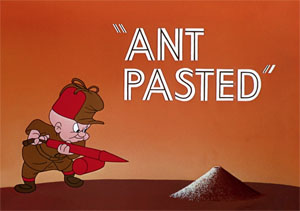 Ant Pasted (Warner, Elmer Fudd, 5/9/53 – I. (Friz) Freleng, dir.) – This may possibly be another instance where a script began life as a vehicle for one character, yet was ultimately produced in the guise of another. It was an infrequent-enough event for Elmer Fudd to star alone in his own cartoon without supporting characters such as Daffy, Bugs, or even the Goofy Gophers. But the plot setup and his motivations in the story strongly suggest that a personality other than his own normal disposition may have been originally intended by the scriptwriter. Elmer’s waging war on a local ant community on the course of shooting firecrackers for the 4th of July seems a bit more openly aggressive that we expect Mr. Fudd to be – suggesting a stronger-willed irascibility may have been sought for the leading role. Thus, a closer personality match to the script’s story line would strongly suggest the likes of Donald Duck, who had performed two similar battles within the past four years in “Tea For Two Hundred” and “Uncle Donald’s Ants”. Intent may thus have been that this script provide a follow up to Donald’s prior insect wars, but somehow, the idea got turned down by Disney and/or Jack Hannah. If this was the case, one might easily imagine that the script went through considerable changes upon reaching Warners, beyond merely substituting Fudd in the title role, as Friz Freleng seems to deserve considerable credit in molding the role of the ants to match his own personal taste and style. They are not Hannah’s ants, but refashioned into more satirical characters capable of lampooning historical events of the recent past or documentary or training films, in the manner which had become a Freleng trademark.
Ant Pasted (Warner, Elmer Fudd, 5/9/53 – I. (Friz) Freleng, dir.) – This may possibly be another instance where a script began life as a vehicle for one character, yet was ultimately produced in the guise of another. It was an infrequent-enough event for Elmer Fudd to star alone in his own cartoon without supporting characters such as Daffy, Bugs, or even the Goofy Gophers. But the plot setup and his motivations in the story strongly suggest that a personality other than his own normal disposition may have been originally intended by the scriptwriter. Elmer’s waging war on a local ant community on the course of shooting firecrackers for the 4th of July seems a bit more openly aggressive that we expect Mr. Fudd to be – suggesting a stronger-willed irascibility may have been sought for the leading role. Thus, a closer personality match to the script’s story line would strongly suggest the likes of Donald Duck, who had performed two similar battles within the past four years in “Tea For Two Hundred” and “Uncle Donald’s Ants”. Intent may thus have been that this script provide a follow up to Donald’s prior insect wars, but somehow, the idea got turned down by Disney and/or Jack Hannah. If this was the case, one might easily imagine that the script went through considerable changes upon reaching Warners, beyond merely substituting Fudd in the title role, as Friz Freleng seems to deserve considerable credit in molding the role of the ants to match his own personal taste and style. They are not Hannah’s ants, but refashioned into more satirical characters capable of lampooning historical events of the recent past or documentary or training films, in the manner which had become a Freleng trademark.
 Elmer drives out to the country for a combination camping trip and opportunity to shoot off several crates of Fourth of July firecrackers and skyrockets. He begins lighting up little ones, one of which rolls to the foot of an anthill. A curious ant sniffs at it, and gets blasted in the face. He vehemently complains in sped-up dialogue, while Elmer comments, “That wittle ant can’t take it. Here’s where I have some fun.” With mischief in his eye definitely ringing of Donald Duck, he mercilessly throws more firecrackers at various anthills, blasting them into open craters. “Of course you know, this means war”, hollers back the ant. In a session of the ant congress, an ant intended to resemble the president (are they doing Roosevelt or Truman?) declares a state of hostilities and receives authority for retaliation. The goldfish bowl is taken out to draw draft numbers, and the recruits report to boot camp. A general sounds the call to arms on a bugle, and now seasoned troops surround Elmer’s camp, one squad evening the odds by slipping over the lines and hijacking one crate of Elmer’s fireworks. An elaborate battle of wits erupts to see who can cause the most explosive damage to each other, with both sides taking a nearly equal share of blasts and powder burns. Amidst these doings, some familiar footage again appears. In the guise of flying ants, Freleng sends in redesigned versions of his mosquitos in stock animation from “Target Snafu”, taking off and flying in the same formations as the previous film, but now armed with payloads of one firecracker each. They swoop in and strafe Elmer’s camp with their explosive cargo causing Elmer to take refuge and more facial damage. “You’ll never take me awive”, shouts Elmer, carting up the remainder of his fireworks in a wheelbarrow, and running down the road over the horizon. He neglects to notice that one firecracker is leaking gunpowder, and the ants take the same advantage of it as Bugs Bunny did in “Bunker Hill Bunny”, reusing Freleng’s gag of lighting the end of the powder trail, and letting the powder act as a relentless fuse to follow its prey wherever he may lead. The burning powder also disappears over horizon, and, after a pause, a gigantic explosion rocks the sky, filling the entire view with dazzling sparks, glitter, and stars, The ant troops patriotically salute the display, and the film fades out.
Elmer drives out to the country for a combination camping trip and opportunity to shoot off several crates of Fourth of July firecrackers and skyrockets. He begins lighting up little ones, one of which rolls to the foot of an anthill. A curious ant sniffs at it, and gets blasted in the face. He vehemently complains in sped-up dialogue, while Elmer comments, “That wittle ant can’t take it. Here’s where I have some fun.” With mischief in his eye definitely ringing of Donald Duck, he mercilessly throws more firecrackers at various anthills, blasting them into open craters. “Of course you know, this means war”, hollers back the ant. In a session of the ant congress, an ant intended to resemble the president (are they doing Roosevelt or Truman?) declares a state of hostilities and receives authority for retaliation. The goldfish bowl is taken out to draw draft numbers, and the recruits report to boot camp. A general sounds the call to arms on a bugle, and now seasoned troops surround Elmer’s camp, one squad evening the odds by slipping over the lines and hijacking one crate of Elmer’s fireworks. An elaborate battle of wits erupts to see who can cause the most explosive damage to each other, with both sides taking a nearly equal share of blasts and powder burns. Amidst these doings, some familiar footage again appears. In the guise of flying ants, Freleng sends in redesigned versions of his mosquitos in stock animation from “Target Snafu”, taking off and flying in the same formations as the previous film, but now armed with payloads of one firecracker each. They swoop in and strafe Elmer’s camp with their explosive cargo causing Elmer to take refuge and more facial damage. “You’ll never take me awive”, shouts Elmer, carting up the remainder of his fireworks in a wheelbarrow, and running down the road over the horizon. He neglects to notice that one firecracker is leaking gunpowder, and the ants take the same advantage of it as Bugs Bunny did in “Bunker Hill Bunny”, reusing Freleng’s gag of lighting the end of the powder trail, and letting the powder act as a relentless fuse to follow its prey wherever he may lead. The burning powder also disappears over horizon, and, after a pause, a gigantic explosion rocks the sky, filling the entire view with dazzling sparks, glitter, and stars, The ant troops patriotically salute the display, and the film fades out.
You can watch it on B98.
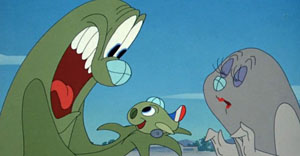 Little Johnny Jet (MGM. 4/18/53 – Tex Avery, dir.) – What is life like after WWII for “an old, burnt out B-29″? This riveting question is answered in high-polished detail by gag king Tex Avery in an Academy Award-nominated gem, providing his own spin on the basic idea of Disney’s “Pedro”, coupled with a splash of his own previous success at updating similar automotive material from the Warner days (“Streamlined Greta Green”) into his own “One Cab’s Family”. Planes thus come to life, with eyes instead of windshields, minds of their own, and full domestic lives to attend to. The film opens on a decorated fighter plane of the great conflict (masterfully voiced by Daws Butler) descending wearily to his home airfield, lifting the door of a hangar like the garage door of a house to admit himself in. His missus, a female plane of similar design, greets him and asks how his day went. (Notably, the respective planes are named John and Mary – allowing for a running gag of repetitions of their names in all manner of variances of mood and intonation, paralleling Daws’ frequent partner Stan Freberg’s hit comedy recording “John and Marsha”, consisting entirely of the two names in varying emotional reads.) Despite displaying his war record, and even his beating purple heart inside his bomb bay, no airport in town has any openings for work for John. Much like Barney Bear’s Peashooter in “The Flying Bear”, our hero plane has found himself outclassed by the latest thing – jets, which are all the airports will hire. To make matters more complicated, he finds Mary concealing an item of knitting – the equivalent of a baby bootie, shaped like a little plane. A blessed event is on the way. Good news, and bad news, as this means “Another propeller to feed.” Now the prospective Papa has to get a job. Mary suggests that he could always reenlist, which raises Papa’s patriotic fervor. “Back to the old Air Corps!” But he receives no more welcome at the recruiting office than in the private sector, where they rubber stamp his tail “Rejected” and boot him out the door, as they are only recruiting jets.
Little Johnny Jet (MGM. 4/18/53 – Tex Avery, dir.) – What is life like after WWII for “an old, burnt out B-29″? This riveting question is answered in high-polished detail by gag king Tex Avery in an Academy Award-nominated gem, providing his own spin on the basic idea of Disney’s “Pedro”, coupled with a splash of his own previous success at updating similar automotive material from the Warner days (“Streamlined Greta Green”) into his own “One Cab’s Family”. Planes thus come to life, with eyes instead of windshields, minds of their own, and full domestic lives to attend to. The film opens on a decorated fighter plane of the great conflict (masterfully voiced by Daws Butler) descending wearily to his home airfield, lifting the door of a hangar like the garage door of a house to admit himself in. His missus, a female plane of similar design, greets him and asks how his day went. (Notably, the respective planes are named John and Mary – allowing for a running gag of repetitions of their names in all manner of variances of mood and intonation, paralleling Daws’ frequent partner Stan Freberg’s hit comedy recording “John and Marsha”, consisting entirely of the two names in varying emotional reads.) Despite displaying his war record, and even his beating purple heart inside his bomb bay, no airport in town has any openings for work for John. Much like Barney Bear’s Peashooter in “The Flying Bear”, our hero plane has found himself outclassed by the latest thing – jets, which are all the airports will hire. To make matters more complicated, he finds Mary concealing an item of knitting – the equivalent of a baby bootie, shaped like a little plane. A blessed event is on the way. Good news, and bad news, as this means “Another propeller to feed.” Now the prospective Papa has to get a job. Mary suggests that he could always reenlist, which raises Papa’s patriotic fervor. “Back to the old Air Corps!” But he receives no more welcome at the recruiting office than in the private sector, where they rubber stamp his tail “Rejected” and boot him out the door, as they are only recruiting jets.
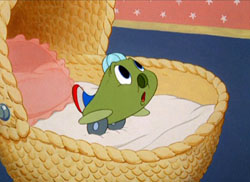 As John trudges home, grumbling over his hatred of jets, he spies the arrival of a helicopter shaped like a stork, dropping a bundle through a hatch in his hangar roof. The new addition to the family is here. John opens the bundle to get a look at his offspring, but is absolutely startled when the fledgling takes off out the hangar door and across the field at nearly supersonic speed. John and Mary duck for cover as the baby makes several more passes in and out of the hangar, then finally comes in for a landing. John is about to praise his son’s skill, when he observes for the first time, “No propeller”. Mary breaks the news to him that Junior is – what else – a jet. At the top of his lungs, Papa screams, “Jets1 Jets! I can’t stand JETS!” Papa drops out of the realm of parental pride, into his own world of solitary sulking, and loathing of the invention that has cost him his livelihood.
As John trudges home, grumbling over his hatred of jets, he spies the arrival of a helicopter shaped like a stork, dropping a bundle through a hatch in his hangar roof. The new addition to the family is here. John opens the bundle to get a look at his offspring, but is absolutely startled when the fledgling takes off out the hangar door and across the field at nearly supersonic speed. John and Mary duck for cover as the baby makes several more passes in and out of the hangar, then finally comes in for a landing. John is about to praise his son’s skill, when he observes for the first time, “No propeller”. Mary breaks the news to him that Junior is – what else – a jet. At the top of his lungs, Papa screams, “Jets1 Jets! I can’t stand JETS!” Papa drops out of the realm of parental pride, into his own world of solitary sulking, and loathing of the invention that has cost him his livelihood.
 A typical morning finds Papa mulling over the morning paper, barely tolerating the constant fly-bys of Junior, who never seems to put his wheels on the ground. Mama adjusts to the new routine, holding up spoons of baby food for Junior to swallow on every pass, then changing diapers by grabbing one off him as he swishes by, then holding up another for him to fly into on the next pass. Meanwhile, John reads the latest aviation news, announcing in headline a round the world air race, with the winner to receive a huge government contract. Of course, the world’s fastest jets are expected to compete. But John, seeing only through eyes red with rage, takes off toward the site of the starting line, grumbling, “I’ll show ‘em.” Mama can’t understand his sudden departure, until she also reads the headline. Placing Junior in a baby carriage, Mary tells her son that they have to stop his father, or he’ll kill himself in that race.
A typical morning finds Papa mulling over the morning paper, barely tolerating the constant fly-bys of Junior, who never seems to put his wheels on the ground. Mama adjusts to the new routine, holding up spoons of baby food for Junior to swallow on every pass, then changing diapers by grabbing one off him as he swishes by, then holding up another for him to fly into on the next pass. Meanwhile, John reads the latest aviation news, announcing in headline a round the world air race, with the winner to receive a huge government contract. Of course, the world’s fastest jets are expected to compete. But John, seeing only through eyes red with rage, takes off toward the site of the starting line, grumbling, “I’ll show ‘em.” Mama can’t understand his sudden departure, until she also reads the headline. Placing Junior in a baby carriage, Mary tells her son that they have to stop his father, or he’ll kill himself in that race.
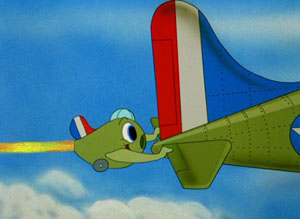 At the event site, John is pleasantly surprised to see a familiar face – another similar bomber, wearing the hat and glasses of General Douglas MacArthur and smoking his style of pipe. Saluting him, John asks, “Morning, sir. Are you flying today?” Paraphrasing MacArthur’s famous quite about “Old soldiers never die”, the plane responds, “Old planes never fly. They just fade away” – which the general then does, right before our eyes. The sleek streamlined jets line up at the starting line, while John sputters his way into position. Mary and Junior arrive, and Mary tries to dissuade John out of this foolhardy plan, not noticing that Junior has opened the door in the side of Papa, and stepped inside. (This always seemed to me a little unnerving – would this qualify as a male pregnancy?) As the racers are told to get on their marks, Mary spots Junior waving to her from the inside of a glass gunner’s turret in Papa’s roof. But she is unable to stop John in time, and the two take off into the blue together – though not quite as planned. As John strains to bring his engines up to speed, the force of the exertion pulls both propeller pods right off his wings, and they each go sailing off into the sky without their owner. With no propulsion, John falls helplessly like a stone. Inside, Junior realizes Papa’s plight, and struggles with Papa’s door to push it open. At the last second, Junior emerges from the side, grabbing hold of John’s tail, and pushing him back into the air, inches from collision with the ground. He waves to his startled dad, and a truce and admiration society are finally struck between father and son, who just saved his Papa’s life. Noting Junior’s tremendous speed despite the extra weight of Papa, John pushes his gunner canopy forward as if wearing a hat at a rakish angle, and says, “Let’s get ‘em, son.” Now, Avery cuts loose with a potpourri of his trademark sight gags on the round the world jaunt. Other jets are passed so quickly, one has to leap into another’s wings to dodge out of the way. Another is “scalped” by Junior’s passing, revealing a bald spot along the top of its fuselage. A skywriter’s advertisement “Drink Zippy Cola” is converted by Junior’s passing into the word “Burp”. A rainbow is tied into a bowknot.
At the event site, John is pleasantly surprised to see a familiar face – another similar bomber, wearing the hat and glasses of General Douglas MacArthur and smoking his style of pipe. Saluting him, John asks, “Morning, sir. Are you flying today?” Paraphrasing MacArthur’s famous quite about “Old soldiers never die”, the plane responds, “Old planes never fly. They just fade away” – which the general then does, right before our eyes. The sleek streamlined jets line up at the starting line, while John sputters his way into position. Mary and Junior arrive, and Mary tries to dissuade John out of this foolhardy plan, not noticing that Junior has opened the door in the side of Papa, and stepped inside. (This always seemed to me a little unnerving – would this qualify as a male pregnancy?) As the racers are told to get on their marks, Mary spots Junior waving to her from the inside of a glass gunner’s turret in Papa’s roof. But she is unable to stop John in time, and the two take off into the blue together – though not quite as planned. As John strains to bring his engines up to speed, the force of the exertion pulls both propeller pods right off his wings, and they each go sailing off into the sky without their owner. With no propulsion, John falls helplessly like a stone. Inside, Junior realizes Papa’s plight, and struggles with Papa’s door to push it open. At the last second, Junior emerges from the side, grabbing hold of John’s tail, and pushing him back into the air, inches from collision with the ground. He waves to his startled dad, and a truce and admiration society are finally struck between father and son, who just saved his Papa’s life. Noting Junior’s tremendous speed despite the extra weight of Papa, John pushes his gunner canopy forward as if wearing a hat at a rakish angle, and says, “Let’s get ‘em, son.” Now, Avery cuts loose with a potpourri of his trademark sight gags on the round the world jaunt. Other jets are passed so quickly, one has to leap into another’s wings to dodge out of the way. Another is “scalped” by Junior’s passing, revealing a bald spot along the top of its fuselage. A skywriter’s advertisement “Drink Zippy Cola” is converted by Junior’s passing into the word “Burp”. A rainbow is tied into a bowknot.
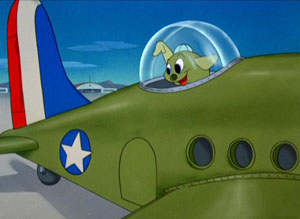 The smog cover is lifted off of Los Angeles. A U.S. Navy blimp is cut in two, revealing its center to be made of watermelon. The leaning tower of Pisa is tilted by Junior in the opposite direction, The Sphinx also receives a crew cur. The Eiffel Tower spreads its “leg” supports to let Junior through. (I’ve always wondered if one gag is missing here, as two gagless aerial shots of Junior turning and changing direction over the continents are oddly placed back to back – could Avery have originally included a gag on Africa, which he was usually fond of including in many a cartoon?) Junior passes over a long ocean liner, compressing it from the force of his passing into a tugboat. As they enter the home stretch, Junior blows up the skits of the Statue of Liberty, revealing a pink bathing suit underneath. John and Junior soar to the finish line unopposed, receiving the cheers of the crowd. “That’s my boy”, John proudly points to Junior. The government contract is awarded – with an unexpected proviso – the Air Force needs ten thousand baby jets immediately! “Ten thousand!” shouts a dismayed John, and nervously looks at his wife. Mary blushes deeply, but is up to the task – revealing that she has already been knitting a string of ten thousand airplane baby booties! The order is on the way.
The smog cover is lifted off of Los Angeles. A U.S. Navy blimp is cut in two, revealing its center to be made of watermelon. The leaning tower of Pisa is tilted by Junior in the opposite direction, The Sphinx also receives a crew cur. The Eiffel Tower spreads its “leg” supports to let Junior through. (I’ve always wondered if one gag is missing here, as two gagless aerial shots of Junior turning and changing direction over the continents are oddly placed back to back – could Avery have originally included a gag on Africa, which he was usually fond of including in many a cartoon?) Junior passes over a long ocean liner, compressing it from the force of his passing into a tugboat. As they enter the home stretch, Junior blows up the skits of the Statue of Liberty, revealing a pink bathing suit underneath. John and Junior soar to the finish line unopposed, receiving the cheers of the crowd. “That’s my boy”, John proudly points to Junior. The government contract is awarded – with an unexpected proviso – the Air Force needs ten thousand baby jets immediately! “Ten thousand!” shouts a dismayed John, and nervously looks at his wife. Mary blushes deeply, but is up to the task – revealing that she has already been knitting a string of ten thousand airplane baby booties! The order is on the way.
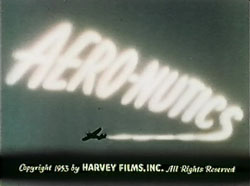 Aero-Nutics (Paramount/Famous, Kartune, 5/8/53 – Seymour Kneitel, dir.) – A plotless spot-gag reel on aviation. It begins at the beginning – with Galileo attempting to experiment with his ornithopter, employing fake wings in an attempt to fly. Instead, he bellyflops into the limbs of a tree, and a nest of eggs hatch below him, the baby birds looking up to call him “Mama”. The Wright Brothers’ first powered flight is next depicted – except the flight is without plane, as the mere draft from starting the propeller blows the pilot and his seat clear off the invention to soar through the air by themselves. A brief variation on the WWI “dogfight” gag follows, with the pursuing plane literally taking a bite upon the forward plane’s tail, causing the forward plane to run away whining in pain. A WWII spitfire uses a convenient spittoon positioned upon a nearby cloud. A supersonic jet is depicted, “burning up the skies”, as it passes a flock of ducks, leaving them barbecued in its exhaust trail. Tex Avery’s “cabin cruiser” gag from “Ceiling Hero” is reused, depicting a plane with a log cabin atop its fuselage, and the gag is further embellished by showing the interior, where two hillbillies dwell with their jugs of corn liquor and an open fireplace, the pilot at a small control panel near the window singing “She’ll be Comin’ ‘Round the Mountain”. In some applications, a helicopter is demonstrated to be more practical than an automobile – as one hovers above a drive-in movie, taking in the show for free. “Blind flying” through hazardous weather is demonstrated by a plane wearing dark glasses in front of its cockpit, whose landing gear are in the form of hands carrying a cane and a tin cup for charitable donations.
Aero-Nutics (Paramount/Famous, Kartune, 5/8/53 – Seymour Kneitel, dir.) – A plotless spot-gag reel on aviation. It begins at the beginning – with Galileo attempting to experiment with his ornithopter, employing fake wings in an attempt to fly. Instead, he bellyflops into the limbs of a tree, and a nest of eggs hatch below him, the baby birds looking up to call him “Mama”. The Wright Brothers’ first powered flight is next depicted – except the flight is without plane, as the mere draft from starting the propeller blows the pilot and his seat clear off the invention to soar through the air by themselves. A brief variation on the WWI “dogfight” gag follows, with the pursuing plane literally taking a bite upon the forward plane’s tail, causing the forward plane to run away whining in pain. A WWII spitfire uses a convenient spittoon positioned upon a nearby cloud. A supersonic jet is depicted, “burning up the skies”, as it passes a flock of ducks, leaving them barbecued in its exhaust trail. Tex Avery’s “cabin cruiser” gag from “Ceiling Hero” is reused, depicting a plane with a log cabin atop its fuselage, and the gag is further embellished by showing the interior, where two hillbillies dwell with their jugs of corn liquor and an open fireplace, the pilot at a small control panel near the window singing “She’ll be Comin’ ‘Round the Mountain”. In some applications, a helicopter is demonstrated to be more practical than an automobile – as one hovers above a drive-in movie, taking in the show for free. “Blind flying” through hazardous weather is demonstrated by a plane wearing dark glasses in front of its cockpit, whose landing gear are in the form of hands carrying a cane and a tin cup for charitable donations.
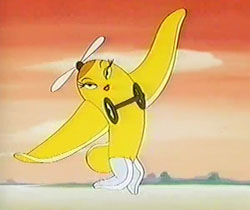 At an airport, a crowd of enthusiastic spectators watches a “take off”, as a female plane strips off its propeller, and peels back fabric from its wing, while a “mail plane” looks on from the field and wolf-whistles. The skill of navigation is illustrated by one such individual who ponders over charts, then merely spits in his hand and splashes the fluid to see which way it blows, then states, “We go thatta way.” A “test pilot” gets his name not from trying out risky flying machines, but from taking cigarette comparison tests, stating “Your brand is milder”. A future aviation traffic cop is depicted, standing aboard a platform suspended by a balloon and directing cross-air traffic, stopping planes in their tracks to let a passing flight of Mama and baby birds through. The hot rod of the future is also depicted, with a college kid having converted an old jalopy (complete with painted slogans on the body like the car of “Freddie the Freshman” or as seen in the feature “Good News”) into a bright red plane. He picks up his date from her upper story window, then leads the audience in a rendition of “Come, Josephine, In My Flying Machine”, the center post of the spinning propeller serving as bounding ball. He brings his date to a cloud-filled aerial lover’s lane, and steals a kiss. His date slaps his face, reaches into her purse, ad pulls out a pocket plane, hopping on to return home alone, for the iris out.
At an airport, a crowd of enthusiastic spectators watches a “take off”, as a female plane strips off its propeller, and peels back fabric from its wing, while a “mail plane” looks on from the field and wolf-whistles. The skill of navigation is illustrated by one such individual who ponders over charts, then merely spits in his hand and splashes the fluid to see which way it blows, then states, “We go thatta way.” A “test pilot” gets his name not from trying out risky flying machines, but from taking cigarette comparison tests, stating “Your brand is milder”. A future aviation traffic cop is depicted, standing aboard a platform suspended by a balloon and directing cross-air traffic, stopping planes in their tracks to let a passing flight of Mama and baby birds through. The hot rod of the future is also depicted, with a college kid having converted an old jalopy (complete with painted slogans on the body like the car of “Freddie the Freshman” or as seen in the feature “Good News”) into a bright red plane. He picks up his date from her upper story window, then leads the audience in a rendition of “Come, Josephine, In My Flying Machine”, the center post of the spinning propeller serving as bounding ball. He brings his date to a cloud-filled aerial lover’s lane, and steals a kiss. His date slaps his face, reaches into her purse, ad pulls out a pocket plane, hopping on to return home alone, for the iris out.
The “take-off” and navigator gags would reappear in the later cheater, Travelaffs (1958), comprised entirely of old segments from Screen Songs and Kartunes.
Just what air traffic needs – someone who can’t see – next time.

